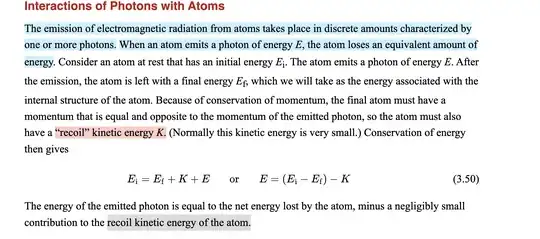In the textbook I am reading for class it is talking about the interactions of photons with atoms and how when an atom emits a photon it must have the same and opposite momentum of the emitted photon. I am confused on what the book means by "the atom must also have a 'recoil' kinetic energy". 
Asked
Active
Viewed 673 times
0
1 Answers
1
A simple research gives several references of a recoil energy, it appears in another question appears in a similar question, an electron is a particle and a photon is also a particle, their interaction should respect the conservation of the energy and the momentum (often ignored in this case). A simple case where the energy and the momentum are important : absorption or emission of free electrons.
In this case of free atoms, the effect depends on the mass of the atom, the photon momentum is given by $p_\lambda=E/c$ and this recoil kinetic energy is given by :
$$K= \frac{1}{2} M_{at} \Big( \frac{p_\lambda}{M_{at}} \Big)^2 = \frac{1}{2} \frac{E^2}{M_{at}c^2} \quad ,$$
$K$ is very weak and negligible especially for heavy atoms.